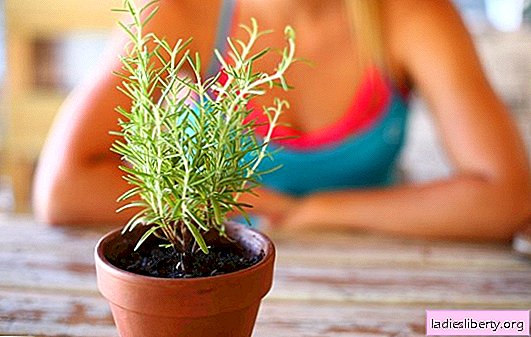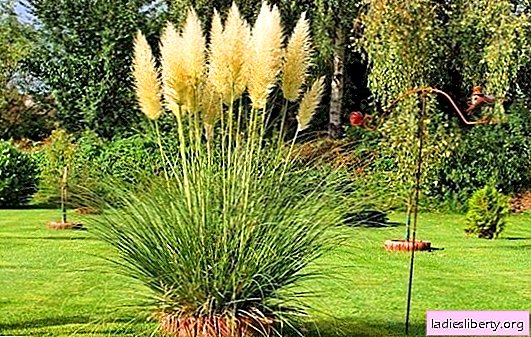
Rosemary in the wild grows on the Mediterranean coast. But this heat-loving plant, if you follow the rules of caring for it, you can grow in middle latitudes - seeds or cuttings.
Rosemary - evergreen perennial, sensitive to cold and demanding to light. Grow it as a spice flavoring and medicinal herb.
Rosemary varieties
Rosemary is a shrub plant extending up to 2 m in length. Its leaves, which look like small needles, exude a spicy, slightly coniferous scent. During the flowering period, the bush is very beautiful - the twigs are covered with small light violet, white or pink buds.
There are very few plant varieties and it will be difficult for an inexperienced gardener to distinguish one from another. Basically, a plant classification by species is used. There are 5 of them in total, but only 2 of them will take root in our climate:
• Rosemary officinalis (ordinary). Erect shrub, actively expanding in length and width. Can grow up to 2 m in length. Leaflets - thin, elongated, green above and white below. Gardeners grow medicinal rosemary for medicinal and cosmetic use. Pay attention to unpretentious varieties of plants - Doctor, Tenderness, Rosinka.
• Rosemary sprawled. This is a low shrub, stretching in length to 0.5 m, greatly expanding in width. Flowers - blue or gentle-lilac. Leaflets - slightly curved down the sides, fragrant. Let us single out the least whimsical subspecies of open rosemary — Corsican, creeping, and lavender.
The choice of varieties is not rich, and therefore, be guided by those goals that you want to achieve - use rosemary only as a dietary supplement or use it to prepare essential oils and tinctures.
Getting the planting material today is not a problem. Buy seeds in flower and gardening shops, and bushes that can be rooted in the ground can be taken even in the supermarket - they are sold as greens.
Where to grow rosemary?
If you are going to grow rosemary, remember that it is heat-loving - lack of sun and severe cold are disastrous for it. To harvest large seasoned aromatic seasonings each season, choose a bush. sunny place protected from harsh winds. With a lack of light, the concentration of essential oils in the leaves will be much lower, which means no benefit and rich taste. The best place for growing bushes - the southern or eastern side of the garden.
If you plan to plant more than one shrub, then select a spacious plot for work, since your “pets” will soon grow very much. Leaf thickening is not needed - fungal diseases will develop and plantings will lose their decorative properties. The specific planting scheme will depend on the selected type of rosemary. If you plant it for ornamental purposes, then there is an opportunity to show all your imagination - plant it as you please, the main thing is that the distance between the bushes is at least 10 cm. at least 50 cm between copies.
The best soil for rosemary is light, well drained, with a neutral reaction. Do not plant bushes on the garden site, where groundwater flows too high to the surface of the earth - they will not tolerate excess moisture. Buy in the store the substrate of the desired acidity or independently alkalize the soil on the site with lime.
Are you going to grow rosemary in containers? Then for the plant, choose large clay vases, which fill the nutrient mixture. This option is convenient because it is closer to autumn, to protect rosemary from the winter cold, you can simply bring it into the house, and not waste time on transplanting. It is possible to prepare such a nutritious soil mixture for growing rosemary in tanks - peat, river sand, leaf soil, turf (1: 1: 2: 2).
Growing rosemary seed
If you live in a warm climate, then sow rosemary can be directly into the ground. But despite the favorable external conditions, the plant will bloom anyway. The best option - preliminary preparation of seedlings.

Rosemary Seeds
To harvest this season in time for this season, start prepare seedlings in February-March. You will need transplant boxes and nutrient soil. Look at the packaging of purchased seeds - many companies offer customers a material that is already fully ready for planting. If you have not found any special instructions, it is better to prepare the seeds in advance - soak them in a damp gauze for several days.
Spread the seeds over the pre-moistened ground, deepening no more than 0.5 cm. To create a greenhouse effect, cover the seed box with a film (make several holes in it with a toothpick) or glass. You will see the first shoots in a couple of weeks. All the while, occasionally remove condensate from the film and moisten the ground with an atomizer.

Rosemary seedlings
For the growth of seedlings do not need to maintain a certain temperature - they take root at 12-22 C. When 3-4 small leaves are formed on the stalks of sprouts, the seedlings can be dived into separate containers - this way the plants will have more room for growth and development. When placing rosemary, try not to damage the root system! 1-2 weeks before disembarking to a permanent place, begin to harden the seedlings, bringing containers with plants out to the street for a short time - they should get used to the external conditions.
Carry rosemary seedlings to the open ground when a stable positive temperature is established outside. Strongly do not bury the seedlings in the soil and do not tamp the soil - the roots will not have enough air.
Growing rosemary from cuttings
According to experienced gardeners, growing rosemary from cuttings is an easier way. In addition, the bush that you get will be an exact copy of the one from which the young shoot has been cut. Planting material can be bought in specialized nurseries or in gardening stores. The best period for this is late spring. Signs of quality cuttings:
• length - 8-10 cm,
• 3-4 internodes.

Rosemary Stalk
For quick rooting, the underside of the cutting can be held in a special solution. Planting should be carried out in a separate pot with a nutrient substrate or directly to open ground. Remove the bottom leaflets from the shoot and insert the seedling 5 cm into the ground at an angle of 30-45˚. You will create favorable conditions for the plant if you cover the sapling with polyethylene or a plastic bottle for about a week. Direct sunlight will not benefit rosemary now.

Rooting Rosemary Cuttings
To expand the area of planting in the future, cuttings can be obtained from their plants. In spring or autumn, cut off young shoots of the desired length from rosemary.
Rosemary Care
Rosemary care does not take much time even for a beginner. When growing a healthy, fragrant plant, pay attention to the following rules:
• Temperature. Rosemary - drought-resistant plant. At temperatures below -6 C, young saplings die, but the adult specimen withstands cold snap up to -9 C. Sharp temperature drops also do not like rosemary.
• Lighting. With a lack of light, rosemary will not give the gardener a strong aroma, since there are few essential oils in it under such conditions of care. Make sure that the plant does not fall shadow.
• Watering. Rosemary likes moist air, so do not forget to regularly spray the bushes with water, especially with regard to plant breeding at home. You can see that rosemary lacks moisture by yellowing leaves, whereas with normal care they are saturated green. Make watering when the top layer of soil dries out by 3-5 cm - do not use cold water. Make sure that the site is not flooded.
• Top dressing. Many gardeners do not feed rosemary at all, but only ensure that there is always a small amount of lime in the soil. If you still want to provide the plant with comprehensive care, fertilize it once a month using mineral supplements or cowshed solution (in a 1: 5 ratio). In the spring, so that the rosemary has a root system, feed it with nitrogen, and in the fall - with phosphorus.
• Crop. Rosemary likes fresh air, so try not to allow its excessive thickening - regularly rejuvenate the shoots by pinching the tops and removing dry inflorescences. If you grow perennial rosemary for decorative purposes, in the beginning of spring and after flowering, make its formative pruning. And once in 7-8 years, you can cut the bush to the level of the soil.
Rosemary does not bloom right away - if you follow the rules of care, you will see beautiful inflorescences already in the 3rd season. Flowering continues until the autumn frosts. And growing bushes at home, flowering can be seen even in winter.
How to save rosemary for the winter?
The best way to save rosemary is cutting. But then in the next season, plant a plant on the site will have to re-
If you live in an area where winters are not very cold, bushes in the fall (better - in September!) Can be covered with dry foliage, straw or spruce branches, after bending them to the ground.
Not sure if rosemary will endure the cold? Better then transfer the tallest specimens home by transplanting them into separate containers - the best option for the middle band! The plant does not necessarily provide for this “special” conditions and care - it will willingly develop in the home microclimate, giving you a stunning aroma.
Rosemary Cultivation: Harvesting and Storage
Cut off fragrant stems and leaves of rosemary can be all summer. Use them immediately for the intended purpose - add to culinary dishes. If for the winter you take the bush into the house, you can also cut fresh greens in winter.
The highest concentration of essential oils in the plant is observed during its flowering period. It is now possible to make harvesting herbs for the winter. Harvest only in sunny weather. It is advisable to cut only the young shoots. Sprigs can be simply tied together with a string and hung to dry in a dark, well-ventilated place. You can use the oven - the drying process then takes not so much time. Pre-cutting of greenery is also allowed. Store dried seasoning in glass jars or canvas bags. As such, it will retain its flavor and beneficial properties for up to 3 years.

Rosemary Drying
Some hostesses freeze the harvest - cut the cut leaves and rosemary stalks, put them in separate plastic bags or plastic containers and send them to the freezer.
Rosemary diseases and pests
Rosemary is rarely affected by diseases and attacks of insect pests. All the "misfortunes" that can overwhelm the bushes are mainly connected with non-compliance with the rules of caring for them.
Rosemary with strong moisture is affected powdery mildew. That is why it is so important to make timely trimming of bushes and to observe the terms of watering. Mealy dew is a fungal disease, the appearance of which on the plant can be determined by the whitish bloom on the stems and leaves. If you notice traces of fungus on rosemary, cut off the damaged parts. To prevent the "epidemic" spray planting special drugs - colloidal sulfur or copper sulfate. But keep in mind that rosemary, where powdery mildew traces were noted, cannot be eaten - wait for fresh shoots!
Of insect pests to rosemary can be dangerous aphid and spider mite. Bugs whole "flocks" settle on the leaves and shoots of the bush, feeding on their juice. It is not difficult to notice the pests, so regularly conduct a visual inspection of plantings. They showed themselves perfectly in the fight against aphids and spider mites insecticides. Plants treated with special means cannot be used as food - harmful substances can cause stomach upsets. Larvae and adult insects can also be removed manually, but this will take a very long time - the technique does not justify itself, since the bugs can attack rosemary again very soon.











